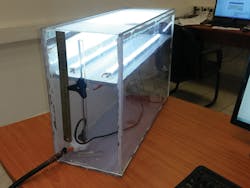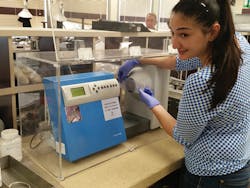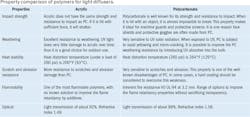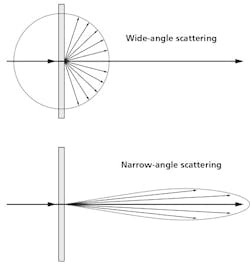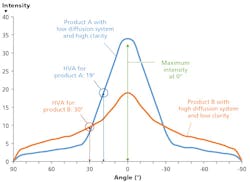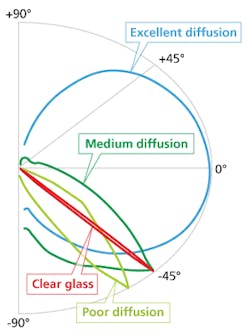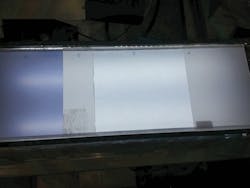Plastic light diffusion systems match LED lighting needs (MAGAZINE) (UPDATED)
GABI BAR and MOIRA NIR explain how to select thermoplastic compounds for SSL optical systems and how to measure the important transmission and diffusion parameters.
In recent years, lighting manufacturers and developers have moved away from traditional light sources and to LED-based solid-state lighting (SSL) technology. While LEDs offer many benefits such as excellent energy efficiency, the point sources also present some problems in general-illumination applications - glare, for instance. So in LED lighting developments, engineers must design lens systems and covers that are optimized in terms of their light diffusion properties to eliminate the LED glare issue.
Interested in articles & announcements on light diffusers & SSL design components?
Glass and transparent plastics, especially acrylic resins, have long been used in the lighting industry for various aesthetic and functional purposes in optics design. But as the lighting market moves increasingly to LED technology, requirements for high light diffusion have spurred lens and cover manufacturers to devote much of their activity to developing suitable plastic solutions.
In this, the first in a two-part article series, we will discuss the issue of light diffusion technology in plastic. This article will focus on selecting the optimal polymer as a carrier for the light diffusion system and on how to measure light diffusion properties. In a subsequent article, we will focus on selecting the optimal light diffusion system.
FIG. 1. The BYK-Gardner haze meter is widely used for appearance
measurement of transparent materials such as films, plaques, plastic
products, lenses, or windshields. The haze meter can measure
light transmission, haze, and clarity.
Selecting the optimal polymer
When selecting the thermoplastic type for a light diffusing cover or lens, there are few candidates that can be considered. The most essential feature is transparency. In its natural form, the polymer must be highly transparent to minimize LED efficiency losses during the light diffusion action.
A short list of engineering polymers can be technically considered as appropriate solutions. But when cost is taken into consideration, only polycarbonate (PC) and acrylic (polymethyl methacrylate, PMMA) are left as possible options, with a basic cost of $2-$3/kg. The price of other engineering or ultra-polymers can reach $20/kg and even higher.
Polycarbonate or acrylic
When considering the choice of PC or PMMA, there is no clear-cut answer. PC and PMMA are very similar in price, processing convenience, and optical properties. But there the comparison ends and the choice depends on application requirements. The table compares properties that manufacturers and developers should consider when selecting between the two polymers.
Manufacturers and developers need to rank priorities of properties to make the best decision. For example, if the plastic part is designed for indoor service, the priority of mechanical properties can be low, and acrylic is the best choice. If optical properties are extremely important and the illuminance level (lux units) is required to be as high as possible, again acrylic might be the right choice. On other hand, if the application requires fire resistance properties because of building standards or risk of fire, polycarbonate will be the only choice.
Modifying polymers
When selecting between acrylic and polycarbonate, the designer does not need to compromise and suffer all the drawbacks of their selection. Here are some examples of optional modifications possible for acrylic and polycarbonate polymers.
In the case of acrylic, you can modify the mechanical properties. Specifically, the low-impact property can be improved in two ways. First, the lens or cover can be designed with thicker walls. A second option is to use high-impact PMMA grades. In that case, beside the extra costs, there is some tradeoff in terms of lower light transmission.
With polycarbonates, you can achieve several types of modifications. Consider ultraviolet (UV) sensitivity that is a problem for a product exposed to sunlight. The poor UV stability of polycarbonates can be largely improved by the introduction of UV absorbers (UVA) into the bulk material. Different levels of UVA will result in different levels of UV stability. For the case in which the cover is produced from a PC sheet, the UV protection can be based on a co-extruded layer of PC enriched with UVA that is much more efficient and cost effective in comparison to the option of addition of the UVA to the bulk.
Scratch resistance can also be addressed. This property can be improved via special coatings applied in a second-stage process. This type of improvement is very popular in the automotive industry in the production of PC lamp covers.
And although polycarbonate is by far better in terms of fire resistance, in some applications further flame-retardant property improvement is required. This is especially true when the product must comply with fire standards. A good example is the European railway norm (EN 45545-2) that covers all parts in the train. For such applications, lighting suppliers must use a special grade of PC that contains flame-resistant additives for the manufacturing of LED covers and lenses.
Measuring light diffusion
Now let's move on to the task of measuring light diffusion and characterizing optical performance. For some of you, this may sound very simple. However, this isn't the case. Manufacturers and developers employ different methods to measure diffusion quality. There is no harmonized method or norm to express light diffusion performance. Due to the lack of uniformity, problems arise in describing light diffusion systems and in the comparison of one system to the other.
Two parameters determine light diffusion performance: light transmission (transparency) level and light diffusion level. It is quite easy and inexpensive to achieve a system with good diffusion and low light transmission, or vice versa a system with high light transmission and poor diffusion. It is much more challenging to achieve a system with both a high light diffusion level and high light transmission which is as close as possible to the original source light level. Therefore, when testing optical performance of the system, both parameters need to be measured: light transmission and light diffusion. The optical quality of the system can be specified only when both parameters are available.
Light transmission measurements. Of the two parameters, light transmission is easier and more straightforward to measure. ASTM D-1003 is a standard test method for haze and luminous transmittance of transparent plastics. This standard has been adopted by most of the plastics converters of transparent or semi-transparent products.
A light transmission meter or haze meter is typically used to measure the light transmission of a plastic film or sheet. An example of a common laboratory haze meter is shown in Fig. 1. The total transmittance is the ratio of the transmitted light to the incident light. Total transmission or light transmission (L.T) is dependent on the material's absorption and reflection properties.
L.T (%) = 100% - Absorption (%) - Reflection (%)
L.T values range between 0% for opaque systems and up to 97-98% for 3-mm glass. Polycarbonate at the same thickness is typically 88-90% and acrylic is 92-93%. Absorption is a function of the material properties and sample thickness. Embedded particles or pigments may also increase the intrinsic value.
The reflection element is also influenced by particles or pigments embedded in the article surface, but not less important is the surface quality. Rough surfaces will result in high scattering while smooth surfaces will reduce scattering to a minimum. Therefore, designing an optic cover or lens with high L.T must take into consideration as smooth a surface as possible.
A haze meter is primarily used to evaluate the semi-finished raw material at the laboratory stage. Thus, this method is limited to the product-development stage. It cannot be used to measure the light transmittance or luminance level of a complete lighting system.
Light diffusion measurements. When we refer to light diffusion in optic covers, we refer to the scattering of the light that is transmitted through the optic cover. Our optimal goal is to obtain high light transmission with high scattering, which yields a "soft" light. To achieve scattering, we can employ translucent materials such as treated glass or treated transparent plastics. Such treated materials can be prepared by incorporating small-scale structures on the surface, or by embedding pigments or small particles into the material.
When we want to report light diffusion properties of an object, it isn't always simple, as producers and designers use different terminology and measurement methods to quantify this property. Even on a laboratory scale, measuring light diffusion properties is more complicated than L.T measurements. The main reason is the fact that the standard laboratory devices, like the haze meter discussed earlier, provide only partial information regarding the system's diffusion performance.
Light diffusion level is typically reported as haze. Haze is defined as the amount of light that is subject to wide-angle scattering, at angles greater than 2.5° from normal. Haze measurements are also conducted according to ASTM D1003, and like L.T measurements, they are also determined by a light transmission meter or haze meter. The main drawback to the haze parameter is its low sensitivity. For medium-to-high diffusion levels, haze can be a good indication of the system performance. However, for highly diffusing systems, the haze value reaches a maximum, and from that level, the meter cannot distinguish between different levels of light diffusion.
A different lab test based on ASTM D1003 is the clarity test. It is a complementary test to the haze test. The clarity test is also conducted by the light transmission meter, but the transmitted values are collected only within the range of 2.5° from the normal. This measurement indicates how well small details can be seen through an optic object. The diffusion properties in this case are tested indirectly. A value of low clarity means that most of the incident light is shifted away from the normal plane to an angle wider than 2.5°. An illustration of wide-angle scattering (low clarity) and narrow-angle scattering (high clarity) is shown in Fig. 2.
transmitted through an optic object. Wide-angle scattering shown
at the top will result with high haze and low clarity. Narrow-angle
scattering show at the bottom will result with low haze and high clarity.
The main advantages of the clarity test are again the availability of the light transmitted and the simplicity of the test. This test is also more sensitive in comparison to haze. But the main drawback is the fact that it is an indirect test. Clarity shows how clear the system is (or is not) around the normal plane, but it does not completely define the object's light diffusion properties.
Half-value angle test
One of the most proficient methods for characterizing quantitative light-diffusion performance is the half-value angle (HVA) test. The test is based on measurements of the light intensity at different angles with respect to the incident light that is vertical to the object surface. It is conducted from -90° to +90°. The final half-value angle is the angle where the light intensity is half of its intensity at the 0° measurement. Wider angles indicate improved light diffusion properties. An example of HVA is shown in Fig. 3.
FIG. 3. The graph provides an example of the half-value angle (HVA) curves
of two diffusion systems measured by a goniometer. System A (blue)
features a sharp curve at the center, indicating lower diffusion performance
and higher clarity. System B (red) has a shallow curve indicating better
diffusion performances and lower clarity. The HVA is calculated based
on the half intensity of the peak intensity for each system.
The HVA measurements are conducted with a goniometer. With appropriate detectors, the goniometer measures light scattering intensity at different angles. This device is more of a research and development tool rather than industrial lab equipment. Goniometers are used to measure angle dependence of various phenomena.
The advantage of the HVA test is its sensitivity, which enables it to distinguish between systems with high light diffusion levels. This sensitivity is impossible to obtain with haze measurements. The disadvantage is the fact that only a few laboratories are equipped to conduct this test due to the high cost of the test equipment.
Light diffusion power
The light diffusion power (LDP) test is also a proficient testing method for characterizing diffusion properties. In fact, the LDP methodology is similar to the HVA method. The main difference is that in the LDP test, the sample is illuminated at an incidence angle of 45°, not 90°. Like the HVA, the radiant intensity on the back side is recorded by a goniometer or another measuring device. The numerical or graphical data is integrated between -85° and +85° and divided by the total area between those angles. An example of LDP graphical data is shown in Fig. 4. At LDP values approaching 1, higher light diffusion power is indicated.
measurements of four different transparent systems:
clear glass (red), poor diffusion system (olive), medium
diffusion (green), and excellent (blue). Light intensity is measured
between -85° to +85°. The area of each graph is divided by
the integrated area between -85° to +85°.
Among manufacturers of sheets, profiles, and lenses, the most common and practiced test is the Hot Spot test. This is a quality test that does not rely on any formal standard but is the most straightforward test that directly indicates the diffusion system performance. The test is conducted in a simple chamber with an array or strips of LEDs located on the bottom of the chamber, as shown in Fig. 5. The tested optical object is placed on the top of the chamber and then the samples are observed from the side opposite the light source in order to determine to what extent the LED hot spots are hidden.
FIG. 5. A Hot Spot chamber provides a simple way to observe
diffusion and transmission properties.
Simple chambers are static, i.e., the distance between the light source and the object is fixed. More advanced chambers allow for changing the distance between the light source and the tested object. In this way, the diffusion properties can be quantified by measuring the minimum distance at which the hot spots are hidden by the object. The ruler on the chamber side indicates the height of the LED strips. As the LED strips are moved closer to the tested objects, it is more difficult to hide the hot spots. Different diffusion systems can be compared visually simultaneously.
Fig. 6 shows a composite of four optic samples illuminated in a Hot Spot test. Sample C best hides the LED point sources. But when considering the tradeoff between diffusion properties and light transmission, developers may select sample B due to the higher transmitted luminance.
reflect the complexity of selecting an optimal diffusion system.
Summary of Part 1
Communicating design criteria for light diffusion properties is not a simple matter. Manufacturers, designers, and customers must pay attention to the tradeoff between diffusion properties and light transmission level. Considering only diffusion performance by itself is meaningless since the material must also transmit light. Among various methods to measure diffusion properties, the half-value angle is the most professional approach. On other hand, the Hot Spot chamber is the most practiced method, if the manufacturers and designers know and have the benchmark that they are trying to achieve. Selecting the optimal light diffusion system by means of the right additives package will be discussed in depth in a future article.
GABI BAR is the global polycarbonate manager and MOIRA NIR, PhD, works in the R&D department at Tosaf Compounds Ltd. (tosaf.com).
*Updated August 1, 2017 11:44am with new figure.
